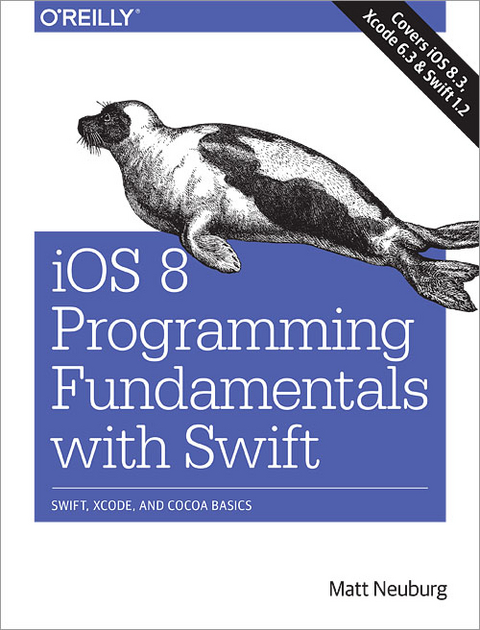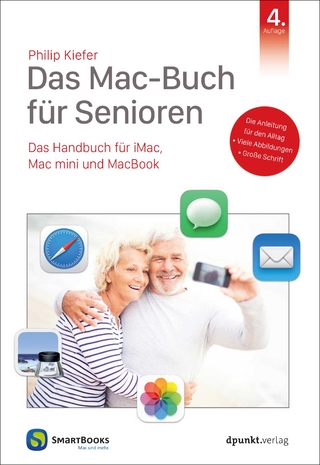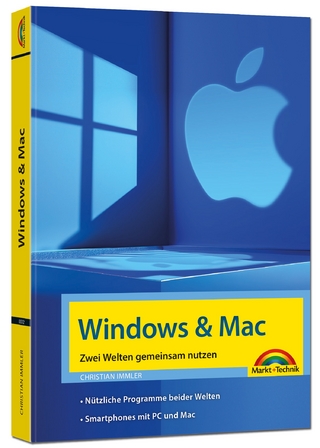
iOS 8 Programming Fundamentals with Swift
O'Reilly Media (Verlag)
978-1-4919-0890-7 (ISBN)
- Titel ist leider vergriffen;
keine Neuauflage - Artikel merken
- Explore Swift’s object-oriented concepts: variables and functions, scopes and namespaces, object types and instances
- Become familiar with built-in Swift types such as numbers, strings, ranges, tuples, Optionals, arrays, and dictionaries
- Learn how to declare, instantiate, and customize Swift object types—enums, structs, and classes
- Discover powerful Swift features such as protocols and generics
- Tour the lifecycle of an Xcode project from inception to App Store
- Create app interfaces with nibs and the nib editor, Interface Builder
- Understand Cocoa’s event-driven model and its major design patterns and features
- Find out how Swift communicates with Cocoa’s C and Objective-C APIs
Once you master the fundamentals, you’ll be ready to tackle the details of iOS app development with author Matt Neuburg’s companion guide, Programming iOS 8.
Matt Neuburg started programming computers in 1968, when he was 14 years old, as a member of a literally underground high school club, which met once a week to do timesharing on a bank of PDP-10s by way of primitive teletype machines. He also occasionally used Princeton University's IBM-360/67, but gave it up in frustration when one day he dropped his punch cards. He majored in Greek at Swarthmore College, and received his Ph.D. from Cornell University in 1981, writing his doctoral dissertation (about Aeschylus) on a mainframe. He proceeded to teach Classical languages, literature, and culture at many well-known institutions of higher learning, most of which now disavow knowledge of his existence, and to publish numerous scholarly articles unlikely to interest anyone. Meanwhile he obtained an Apple IIc and became hopelessly hooked on computers again, migrating to a Macintosh in 1990. He wrote some educational and utility freeware, became an early regular contributor to the online journal TidBITS, and in 1995 left academe to edit MacTech Magazine. He is also the author of Frontier: The Definitive Guide and REALbasic: The Definitive Guide. In August 1996 he became a freelancer, which means he has been looking for work ever since. He is the author of Frontier: The Definitive Guide and REALbasic: The Definitive Guide, both for O'Reilly & Associates.
Language
Chapter 1The Architecture of Swift
Ground of Being
Everything Is an Object?
Three Flavors of Object Type
Variables
Functions
The Structure of a Swift File
Scope and Lifetime
Object Members
Namespaces
Modules
Instances
Why Instances?
self
Privacy
Design
Chapter 2Functions
Function Parameters and Return Value
External Parameter Names
Overloading
Default Parameter Values
Variadic Parameters
Ignored Parameters
Modifiable Parameters
Function In Function
Recursion
Function As Value
Anonymous Functions
Define-and-Call
Closures
Curried Functions
Chapter 3Variables and Simple Types
Variable Scope and Lifetime
Variable Declaration
Computed Initializer
Computed Variables
Setter Observers
Lazy Initialization
Built-In Simple Types
Chapter 4Object Types
Object Type Declarations and Features
Enums
Structs
Classes
Polymorphism
Casting
Type Reference
Protocols
Generics
Extensions
Umbrella Types
Collection Types
Chapter 5Flow Control and More
Flow Control
Operators
Privacy
Introspection
Memory Management
IDE
Chapter 1Anatomy of an Xcode Project
New Project
The Project Window
The Project File and Its Dependents
The Target
From Project to Running App
Renaming Parts of a Project
Bilingual Targets
Chapter 2Nib Management
A Tour of the Nib Editor Interface
Nib Loading
Connections
Additional Configuration of Nib-Based Instances
Chapter 3Documentation
The Documentation Window
Class Documentation Pages
Sample Code
Quick Help
Symbols
Header Files
Internet Resources
Chapter 4Life Cycle of a Project
Device Architecture and Conditional Code
Version Control
Editing and Navigating Your Code
Running in the Simulator
Debugging
Unit Testing
Clean
Running on a Device
Profiling
Localization
Archiving and Distribution
Ad Hoc Distribution
Final App Preparations
Submission to the App Store
Cocoa
Chapter 1Cocoa Classes
Subclassing
Categories and Extensions
Protocols
Some Foundation Classes
Accessors, Properties, and Key–Value Coding
The Secret Life of NSObject
Chapter 2Cocoa Events
Reasons for Events
Subclassing
Notifications
Delegation
Data Sources
Actions
The Responder Chain
Key–Value Observing
Swamped by Events
Delayed Performance
Chapter 3Memory Management
Principles of Cocoa Memory Management
Rules of Cocoa Memory Management
What ARC Is and What It Does
How Cocoa Objects Manage Memory
Autorelease Pool
Memory Management of Instance Properties
Retain Cycles and Weak References
Unusual Memory Management Situations
Nib Loading and Memory Management
Memory Management of CFTypeRefs
Property Memory Management Policies
Debugging Memory Management Mistakes
Chapter 4Communication Between Objects
Visibility by Instantiation
Visibility by Relationship
Global Visibility
Notifications and KVO
Model–View–Controller
Appendix C, Objective-C, and Swift
The C Language
Objective-C
| Erscheint lt. Verlag | 5.5.2015 |
|---|---|
| Verlagsort | Sebastopol |
| Sprache | englisch |
| Maße | 185 x 230 mm |
| Gewicht | 986 g |
| Einbandart | kartoniert |
| Themenwelt | Informatik ► Betriebssysteme / Server ► Macintosh / Mac OS X |
| Informatik ► Programmiersprachen / -werkzeuge ► Mac / Cocoa Programmierung | |
| Informatik ► Weitere Themen ► Smartphones / Tablets | |
| Schlagworte | Apple iOS 8 • Cocoa (Entwicklungsumgebung) • iOS 8 Handbuch • Swift (Programmiersprache); Einführung • Xcode |
| ISBN-10 | 1-4919-0890-4 / 1491908904 |
| ISBN-13 | 978-1-4919-0890-7 / 9781491908907 |
| Zustand | Neuware |
| Informationen gemäß Produktsicherheitsverordnung (GPSR) | |
| Haben Sie eine Frage zum Produkt? |
aus dem Bereich


